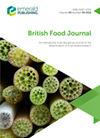Assessing land, nutrients and monetary value associated with postharvest loss of persimmon in Brazil: pathways toward sustainability in agri-food systems
IF 3.4
3区 经济学
Q1 AGRICULTURAL ECONOMICS & POLICY
引用次数: 0
Abstract
PurposeThis study estimates the land footprint, nutrients and monetary value of persimmon loss in Brazil, and also consolidated the methodological approach for assessing resources related to food loss.Design/methodology/approachIt uses data on the harvested area, production, production loss and production value of persimmon in Brazil from 2014 to 2019. The persimmon loss in Brazil was converted into macro- and micronutrients, land use and monetary value.FindingsThe average annual production loss, loss production value and land footprint of persimmon are 35,100 tons, US$12m and 1,673 hectares, respectively. Persimmon loss represents the average loss per year of 6.6bn grams of carbohydrates, 1.6bn grams of food fibers, 7.2bn milligrams of vitamin C, 41.8bn micrograms of vitamin A, 4.5bn milligrams of calcium and 54.8bn milligrams of potassium. These nutrients have the potential to meet the nutritional daily needs of approximately 135,000, 176,000 people, 270,000, 164,000, 12,000 and 32m, respectively.Practical implicationsThrough (1) research and innovation; (2) infrastructure development; (3) training and education; (4) collaboration and networking; and (5) market diversification and value addition, people can increase persimmon shelf life, reduce postharvest losses and create a resilient environment for small persimmon farmers. This approach promotes sustainability in the agri-food system and empowers stakeholders.Originality/valueThis investigation helps to understand the value of food loss, considering the use of natural resources, as well as the loss of nutrients and monetary value.评估与巴西柿子采后损失相关的土地、养分和货币价值:实现农业粮食系统可持续性的途径
目的本研究估计了巴西柿子损失的土地足迹、营养成分和货币价值,并巩固了评估与粮食损失相关资源的方法论方法。设计/方法论/方法它使用了2014年至2019年巴西柿子收获面积、产量、生产损失和产值的数据。巴西柿子的损失转化为宏观和微量营养素、土地利用和货币价值。调查结果柿子年均产量损失3.51万吨,产值损失1200万美元,占地面积1673公顷。柿子每年平均损失66亿克碳水化合物、16亿克食物纤维、72亿毫克维生素C、418亿微克维生素A、45亿毫克钙和548亿毫克钾。这些营养素有可能分别满足约13.5万、17.6万、27万、16.4万、1.2万和3200万人的日常营养需求。实践意义通过(1)研究和创新;(2) 基础设施发展;(3) 培训和教育;(4) 协作和联网;(5)市场多元化和增值,人们可以延长柿子的保质期,减少采后损失,为小柿子农户创造一个有韧性的环境。这种方法促进了农业食品系统的可持续性,并赋予利益相关者权力。独创性/价值这项调查有助于了解食物损失的价值,考虑到自然资源的使用,以及营养物质和货币价值的损失。
本文章由计算机程序翻译,如有差异,请以英文原文为准。
求助全文
约1分钟内获得全文
求助全文
来源期刊

British Food Journal
工程技术-食品科技
CiteScore
6.90
自引率
15.20%
发文量
219
审稿时长
18-36 weeks
期刊介绍:
After 115 years, the British Food Journal (BFJ) continues to be highly respected worldwide for its broad and unique interdisciplinary coverage of the latest food-related double blind peer-reviewed research. It links all sectors of this dynamic industry, keeping abreast of emerging trends, topical and controversial issues and informing and stimulating debate. - See more at: http://emeraldgrouppublishing.com/products/journals/journals.htm?id=bfj#sthash.O3wH4pEh.dpuf
 求助内容:
求助内容: 应助结果提醒方式:
应助结果提醒方式:


